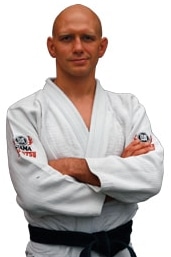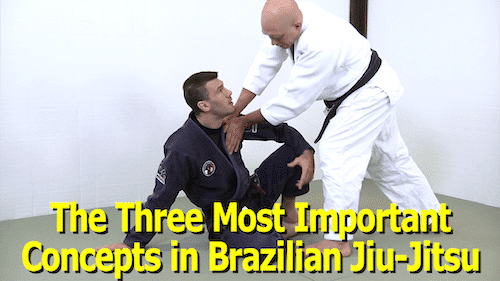
The idea that overall body alignment in BJJ can be broken down into 3 components (base, posture and structure) was introduced to me by Rob Biernacki.
And I have found these 3 concepts to have hugely practical applications on the mat.
There is power in definitions and distinctions because it allows you to clarify your thinking and problem solving processes.
So let’s take a look at base, posture and structure one by one…
(If you would prefer to consume this information in video format and get even more examples of how these concepts apply to jiu-jitsu then check out the brand new video towards to the bottom of the page.)
BASE IN BJJ
Many people think of ‘base’ as stability and being hard to move. That’s partially true, but that there’s a lot more to it than that.
To illustrate this point, suppose you’re spread-eagled on the floor. In that position you’re definitely stable and hard to move, but you’re not posing a danger to anyone and are likely to get tapped out in a hurry.
Instead a more useful definition of base “A platform from which to apply and absorb force.”
Most of the time you’ll be pushing off your opponent to generate base, but sometimes it’ll be a wall, the cage, or your opponent.
If you have good base then it’s hard for your opponent to push or pull you around.
But at the same time if you suddenly decide that you want to move your opponent then you’re in a good position to do so.
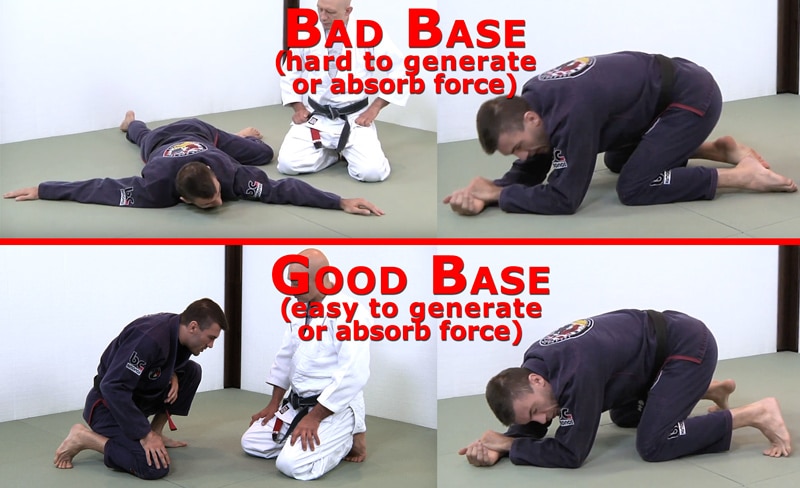
To be in good base you need to be up on the balls of your feet when you’re kneeling, and in an athletic stance when you’re standing. From the balls of your feet (live toes) you can drive forward effectively, whereas when you’re resting on the tops of your feet (dead toes) you’re just kind of stuck.
This one little adjustment of your toes – shown on the right side of the picture above – makes a huge difference. And there are many other tweaks and adjustments you can make to improve your base even further.
The bottom line is that good base allows you to generate maximum force with minimum effort.
It allows you to conserve your energy and use less strength to accomplish the same goals, which is ALWAYS a good thing in Brazilian jiu-jitsu!
POSTURE IN BJJ
Posture refers to having your spine in strong position, from your neck all the way down to your lower back.
If your spine is bent or twisted then you won’t be able to generate a lot of force because your kinetic chain is broken.
To use a weightlifting analogy, imagine trying to do a bench press with your lower body twisted to the side… Or doing a heavy squat with someone bending your neck sideways…
Basically you would be unable to produce force effectively and likely both drop the barbell and set yourself up for catastrophic injury.
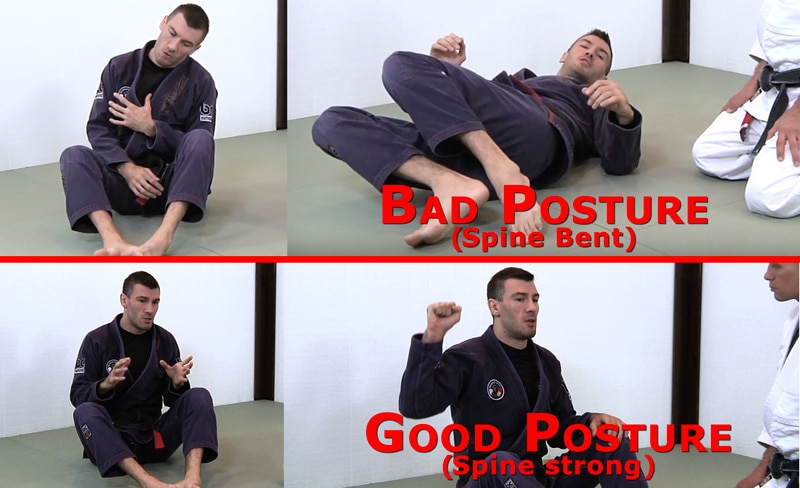
Just like having good base allows for maximum force production and maximum efficiency, good posture also enables you to use your body effectively and efficiently.
If you allow your spine to get bent, twisted or misaligned while doing a technique then it’s much less likely to succeed. And, even worse, you’re much more likely to get injured when you’re straining away in bad posture.
It can take some time to figure out what optimal posture is in the BJJ context, but it’s totally worth the effort. Start by watching at least the technical standup portion of the video close to the bottom of the page (from 6:20 onward).
STRUCTURE IN BJJ
Structure is defined as “The most efficient way to use your limbs.”
Imagine you had to hold a pushup position for as long as possible…
It would be totally inefficient to hold that pushup with your arms bent. Your muscles would fatigue much faster than they would if your arms were straight.
In a straight armed pushup position you’re using bones to support weight rather than muscle. In this scenario a straight arm is the most efficient use of your limbs, and that is the definition of good structure.
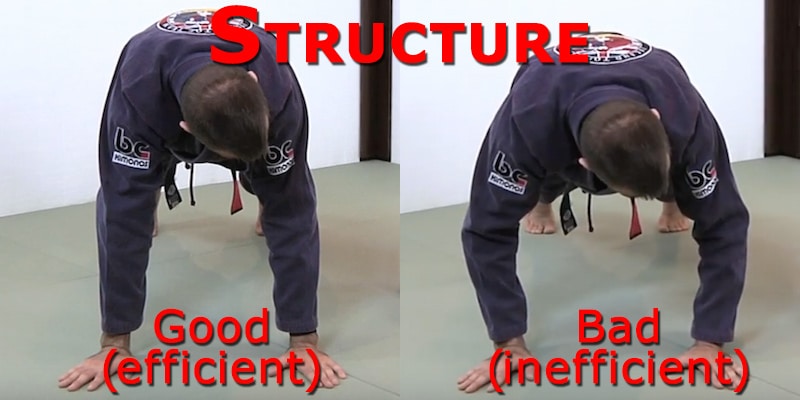
Another example of efficient structure can be found in a blog post I did a little while ago on guard retention. As I discussed in that article, one of the most important techniques you can use to prevent people from passing your guard is the frame and hip escape movement.
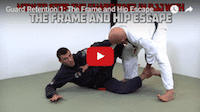 If you read that article and/or watched the videos for the frame and hip escape, did you notice how often the framing motion is often done with an entirely straight arm?
If you read that article and/or watched the videos for the frame and hip escape, did you notice how often the framing motion is often done with an entirely straight arm?
When there isn’t enough room to extend your arm fully straight then you can also do the frame and hip escape by placing your elbow or lower forearm on your opponent. This means that your humerus (the bone in your upper arm) is between you and your opponent, in line with the force vector.
In both applications you’re using the strength of your skeleton rather than the strength of your muscles. Triceps tire out a lot faster than humeruses (or is that ‘humeri’, I’m not quite sure…)
Does that mean that you should have your arms straight in every situation? Not at all; after all, every beginner learns that straight arms on the chest from the bottom of mount give your opponent an instant armbar.
But whenever you can use your bones instead of your muscles do so!
Jiu-jitsu is hard enough without having to muscle everything. Use ‘structure’ properly and let your skeleton do its share of the work.
ALIGNMENT
If you put base, posture and structure together then you get overall ‘alignment’, and it’s good alignment or bad alignment that really makes the difference in BJJ.
If you find yourself struggling with a technique then chances are that there’s a problem with your alignment. Somewhere, somehow you’re sabotaging yourself with poor base, posture or structure.
Not only do you want to put yourself into good alignment, but you also want to put your opponent into bad alignment.
If your opponent is in great alignment then it’s going to be really hard to get any offensive technique to work against him. But if he’s in sufficiently bad alignment then you can probably pull off any technique you feel like doing.
So the real battle is to disrupt his alignment first, and then attack second.
This talk of base, posture, structure and alignment isn’t theoretical handwaving; it’s directly applicable to your jiu-jitsu and tapping out more people! Two concrete examples of BJJ alignment are shown on the video below.
First, at 6:20 Rob takes the technical standup movement and breaks it down in detail for you.
Secondly, at 10:30 in the video Rob shows how applying these concepts transformed his deep half guard entry.
Check it out:
“With concept based learning you are able to acquire a much smaller number of core principles that govern physics and body mechanics and then learn that all the “moves” are just expressions of those principles.” — Rob Biernacki
The ‘BJJ Core Concepts’ for Your Smartphone or Tablet
The concepts we discussed in this article, and the video clip above, are both from the Core Concepts of BJJ app.
This video-based instructional app is available for your smartphone or tablet, and for Apple and Android devices.
It contains more than 1.5 hours of filler-free instruction where we do a deep dive into the various concepts underlying effective and efficient grappling.
All the material covered is applicable to both gi and no gi.
You can get more information, see screenshots, and – if you wish – purchase the app by clicking on one of the buttons below.
Thank you
Stephan Kesting
Grapplearts.com
 For iPhone and iPad CLICK HERE
For iPhone and iPad CLICK HERE
 For Android Phones and Tablets CLICK HERE
For Android Phones and Tablets CLICK HERE

